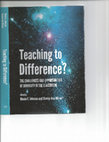Publications by Sean Robinson
Professional Education at Historically Black Colleges and Universities: Trends, Experiences & Outcomes , 2018
Advancing Doctoral Leadership Education , 2018
The Dynamic Student Development Meta-Theory: A New Model for Student Success , 2018
College at the Crossroads: Taking Sides on Contested Issues , 2018
Women & Language, 2018
Anecdotes, blogs, and personal accounts within higher education shows that the experiences of sel... more Anecdotes, blogs, and personal accounts within higher education shows that the experiences of self-identified gender and sexual minority faculty at all levels still often include homophobia, heterosexism, isolation, hostility, and career stagnation. This paper presents a narrative poem of one gender-queer, non-binary faculty member, drawn from a larger qualitative study of 70 LGBTQ+ faculty members. In this poem, I convey a sense of who he is, of what he experienced as an early career academic. His poem serves as a way of “communicating the truth of experience—this is not fixed or universal truth (Truth with a capital T) but rather truth that is felt and understood in the moment, truth that may shift and become something else” (Leavey, 2010, p. 240).
LGBTQ Voices in Education: Changing the Culture of Schooling, 2016
Given the ubiquitous nature and forms of media present in our daily lives, the “informal” pedagog... more Given the ubiquitous nature and forms of media present in our daily lives, the “informal” pedagogies of the popular culture and media appear to be quickly surpassing the “formal” educational pedagogies present in schools and universities. The images and information youth are exposed to everyday are not just forms of entertainment; they serve both cultural and pedagogical functions as well. In light of the manner in which media representations shape one’s definition of identity and social reality, the purpose of this chapter is to explore the intersection of the media and LGBTQ representations and to highlight the underutilized role of media as an educational tool in addressing LGBTQ issues.
Contemporary Studies of Sexuality & Communication: Theoretical and Applied Perspectives, 2016
This chapter explores the role that celebrities play in the loves of LGBTQ youth, as both role mo... more This chapter explores the role that celebrities play in the loves of LGBTQ youth, as both role models and mentors. Given the ubiquitous nature of social media in the lives of youth, many youth are now engaging in parasocial interactions with celebrities and see them as part of their larger social network. Drawing on Lady Gaga as an extreme example I showcase how social media sites such as twitter and Facebook can create parasocial relationships that become almost a mentorship in the eyes of youth.

A lack of a theoretical stance, useful techniques or accessible understandings of the role of sex... more A lack of a theoretical stance, useful techniques or accessible understandings of the role of sexuality in the classroom has often left little room for LGBTQ faculty to know how, when, or why to come out as LGBTQ, or to teach with our sexuality (rather than against it). Too often personal disclosures about our sexuality and our private lives are left to office conversations, or hallway sidebars, and rarely to a full integration in the classroom. LGBTQ faculty often struggle with the questions of whether to come out, and if so when and how to do so in a class. Given that I identify publicly as a queer, gay male university faculty member, the purpose of this chapter is to present my own narrative related to my work and the ways in which my queerness gets realized and played out in my college classes. Two primary questions drive my narrative: how do I connect to my students from a gendered and queer perspective, and what are the challenges and opportunities that present themselves in my classrooms?

As educational institutions continue their calls for greater accountability and learning outcomes... more As educational institutions continue their calls for greater accountability and learning outcomes takes center stage, faculty, administrators, and institutions alike must assume a broader, more holistic approach to teaching and learning. As outlined in this chapter, technology and virtual spaces, when utilized well, can radically shift how graduate faculty can help doctoral students become critical and reflective thinkers, to develop or refine a professional identity, and help them to transform their assumptions about their knowledge and about themselves, a process that Kegan (1994) and Baxter Magolda (1999) call self-authorship. Using digital narratives as part of a technology mediated classroom that is built around a learning partnerships and principles of self-authorship is one way to accomplish this. Such an approach can lead to innovative practices in the classroom, deeper, more reflective learning for students, and greater overall success for our institutions. By combining multimedia tools and technology with an adult learning-centered pedagogy built around self-authoring practices of student development, faculty can more effectively organize doctoral education to engage and involve students in the process and to truly cultivate a new generation of doctoral students as scholars, researchers, and practitioners
Academic Exchange Quarterly, Jan 1, 2010
Academic Exchange Quarterly, Jan 1, 2009
Journal of Gay & Lesbian Social Services, Jan 1, 1994
Counseling Gay Males with AIDS Psychosocial Perspectives C. Sean Robinson ABSTRACT. As the incide... more Counseling Gay Males with AIDS Psychosocial Perspectives C. Sean Robinson ABSTRACT. As the incidence of acquired immune deficiency syn-drome (AIDS) increases, persons with AIDS will present themselves for counseling in both the private and public sector. ...
Although there is a significant body of research on the process of undergraduate education and re... more Although there is a significant body of research on the process of undergraduate education and retention, much less research exists as it relates to the doctoral experience, which is intended to be transformational in nature. At each stage of the process students are presented with ...
As noted in chapter 3, workplace bullying has been proven to disproportionately affect those who ... more As noted in chapter 3, workplace bullying has been proven to disproportionately affect those who are outside of the mainstream culture because of race, gender, or organizational position. In short, those who do not confirm to the hegemonic culture’s expectations are more likely to be the targets of bullying. This fact remains particularly evident in the examination of the gender and sexual minority (GSM) sample of this data collection. Rarely is 100% of one sample affected by bullying, as is the case of GSM employees working in community colleges. Therefore, this conceptual essay will use Allport’s (1979) theory on prejudice and descriptive statistics to reflect on the campus cultures that allow for GSMs to consistently face such abuse on the community college campus.
Papers by Sean Robinson











Uploads
Publications by Sean Robinson
Coercive Community College: Abstracts by Sean Robinson
Papers by Sean Robinson